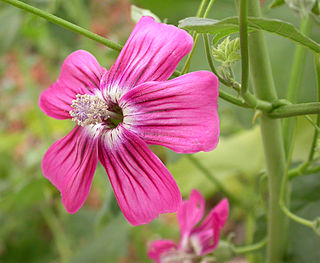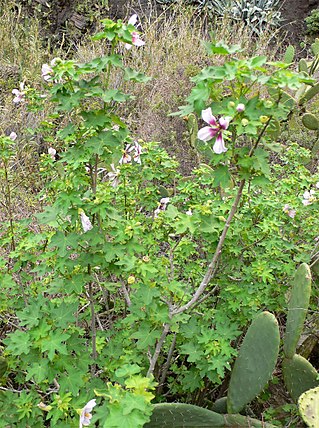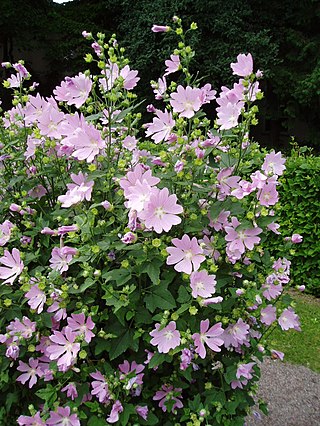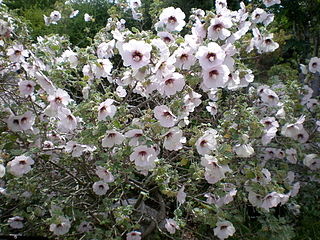Mallow or mallows may refer to:

Malvoideae is a botanical name at the rank of subfamily, which includes in the minimum the genus Malva. It was first used by Burnett in 1835, but was not much used until recently, where, within the framework of the APG System, which unites the families Malvaceae, Bombacaceae, Sterculiaceae and Tiliaceae of the Cronquist system, the aggregate family Malvaceae is divided into 9 subfamilies, including Malvoideae. The Malvoideae of Kubitzki and Bayer includes 4 tribes:

Malva phoenicea, often still known under the synonyms Lavatera phoenicea and Navaea phoenicea, is a large shrub of the family Malvaceae and tribe Malveae, endemic to the island of Tenerife in the Canary Islands.

Malva assurgentiflora, formerly classified as Lavatera assurgentiflora, the island mallow, mission mallow, royal mallow, malva rosa island mallow, island tree mallow or malva rosa in Spanish, is a species of flowering plant in the mallow family.

Malva trimestris, common names annual mallow, rose mallow, royal mallow, regal mallow, and common annual tree mallow is a species of flowering plant native to the Mediterranean region.

Malva acerifolia, also frequently known under the synonyms Lavatera acerifolia or Malva canariensis is a shrub endemic to the Canary Islands, belonging to the family Malvaceae.

Malva thuringiaca, the garden tree-mallow, is a species of flowering plant in the mallow family Malvaceae, native to eastern Europe and southwestern Asia, from southern Germany south to Italy, and east to southern Russia, Kazakhstan, and Turkey.

Malva arborea, the tree mallow, is a species of mallow native to the coasts of western Europe and the Mediterranean region, from Ireland and Britain south to Algeria and Libya, and east to Greece.
Malva vein clearing virus also known as MVCV is a species of Potyvirus in the family Potyviridae that was isolated in 1957 from Malva sylvestris in Germany which is transmitted by the aphids Aphis umbrella and Myzus persicae. The insects mechanically inoculate the malvaceous hosts.

Malva multiflora is a species of flowering plant in the mallow family known by the common names Cornish mallow and Cretan hollyhock. It is native to western Europe, North Africa, and the Mediterranean Basin, and it is naturalized in areas with a Mediterranean climate, such as parts of Australia, South Africa, and California. This is an annual or biennial herb growing a tough, somewhat hairy stem to a maximum height between 1 and 3 meters. The leaves are multilobed with flat or wavy edges, slightly hairy, and up to 10 centimeters long. The plant bears small pink or light purple flowers with petals just over a centimeter long. The fruit is disc-shaped with 7 to 10 segments.

Carcharodus alceae, the mallow skipper, is a butterfly of the family Hesperiidae.

Puccinia malvacearum, also known as hollyhock or mallow rust, is a species within the genus Puccinia known for attacking members of the family Malvaceae. An autoecious pathogen, it can complete its life cycle using a single host.
Acrocercops malvacea is a moth of the family Gracillariidae, known from Morocco. It was described by Walsingham, Lord Thomas de Grey, in 1907. The hostplant for the species is Lavatera olbia and Malva species.

Malva punctata, commonly called spotted-stalked tree-mallow or annual tree mallow, is an annual herbaceous plant belonging to the genus Malva of the family Malvaceae.

Larentia malvata is a moth of the family Geometridae. It was described by Rambur in 1833. It is found in Portugal, Spain, France, Italy, Croatia, Greece, as well as on Sardinia, Corsica, Sicily, Malta and Crete.
Platyedra subcinerea, the mallow groundling or cotton stem moth, is a moth of the family Gelechiidae. It is found in most of Europe. It is an in introduced species in North America, where it has been recorded from New England and California, and has also been introduced to New Zealand. The habitat consists of wet meadows, marshes and gardens.
L. abyssinica can refer to a few different species. The specific epithet abyssinica refers to Ethiopia, where many of these species may be found.

Malva subovata, the tree mallow, is a species of flowering plant in the family Malvaceae, native to the shores of the western and central Mediterranean. As its synonym Lavatera maritima it has gained the Royal Horticultural Society's Award of Garden Merit.

Malva hispanica, the Spanish mallow, is a species of flowering plant in the family Malvaceae, native to the western Mediterranean. Uniquely in its genus, Malva hispanica flowers possess a bilobed epicalyx, which is derived from an ancestral trimerous structure and represents a loss of the adaxial epicalyx lobe.













